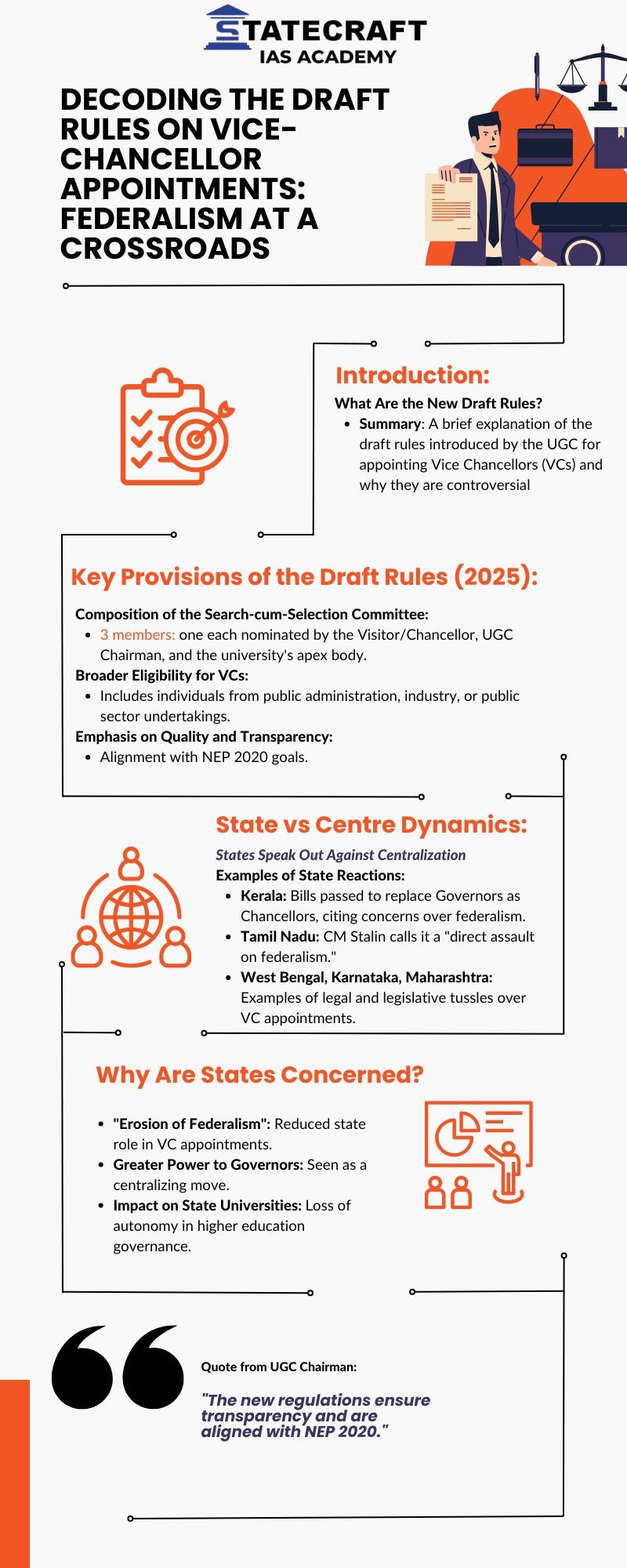Index:
- Gaza Ceasefire Agreement – Key Points
- Kashi Tamil Sangamam 3.0
- India's Goods Exports and Trade Deficit – December 2024
- Kolkata's Heritage Lighting Initiative
- Infrastructure in Government Schools – UDISE Report 2024
- Burrow Tragedy - Lessons from Mining Disasters
- Safety and Piety: Managing Religious Gatherings
- The commissioning of INS Nilgiri, INS Vaghsheer, and INS Surat
- Decoding the Draft Rules on Vice-Chancellor Appointments Federalism at a Crossroads - Infographic
- Why India is Warming Slower - Infographic
1. Gaza Ceasefire Agreement – Key Points
- Agreement Details: Parties Involved: S., Hamas, and Israel, with Egypt and Qatar mediating.
- Terms of Ceasefire:
- Six-week pause in fighting.
- Gradual release of hostages by Hamas and Palestinian prisoners by Israel.
- Humanitarian aid to flow into Gaza.
- Displaced Palestinians to return to their homes, though extensive destruction persists.
- Terms of Ceasefire:
- Casualties and Impact:
- Trigger Event: Hamas’ October 7, 2023, cross-border attack (1,200 Israelis killed, 250 hostages taken).
- Israeli Response: Over 46,000 Palestinians killed; majority displaced (90% of Gaza’s 2.3 million population).
- Extensive infrastructure destruction and humanitarian crisis.
- Post-War Concerns:
- Reconstruction of Gaza and governance issues remain unresolved.
- Long-term stability in the region uncertain.
- Mediation Efforts:
- Ceasefire follows indirect negotiations in Doha, Qatar.
- Also linked to ceasefire agreements involving Hezbollah in Lebanon.
- Humanitarian Crisis: UN and relief organizations highlight displacement, famine risks, and healthcare collapse in Gaza.
- Future Outlook:
- Discussions on permanent ceasefire and Israeli troop withdrawal expected during the six-week truce.
- Global focus on addressing long-term Middle East stability.
2. Kashi Tamil Sangamam 3.0
- Event Overview:
- Theme: Legacy and philosophy of Maharishi Agasthyar.
- Location: Namo Ghat, Varanasi.
- Dates: February 15 to February 24, 2025.
- Organized by the Union Education Ministry.
- Significance of Maharishi Agasthyar:
- Recognized as the intellectual foundation of Tamil language and literature.
- Symbol of shared heritage, knowledge traditions, and cultural values of India.
- Special Features: Release of two significant documents:
- Agasthyar Temples in Tamil Nadu.
- Siddha Medicine (Traditional Tamil medical system).
- Focus on cultural integration and celebrating the timeless bond between Tamil Nadu and Kashi.
- Participants and Categories:
- Total Delegates: 1,200 from Tamil Nadu.
- Categories:
- Students, teachers, and writers.
- Farmers and artisans.
- Professionals and entrepreneurs.
- Women from various sectors.
- Innovators, start-ups, edu-tech, and researchers.
- New Addition: Around 200 Tamil-origin students from Central universities.
- Registration Process:
- Portal: kashitamil.iitm.ac.in.
- Last Date: February 1, 2025.
- Participants to be selected via a Tamil quiz on February 2, 2025.
- Context:
- The event will coincide with the Kumbh Mela.
- Aimed at fostering cultural integration, not political agendas.
3. India's Goods Exports and Trade Deficit – December 2024
Key Highlights:
- Exports and Imports:
- Exports: Decreased by 1% YoY in December to $38.01 billion.
- Imports: Increased by 9% YoY to $59.95 billion.
- Trade Deficit: Narrowed to a three-month low of $21.9 billion, from November’s record $31.8 billion.
- Gold Imports:
- Fell significantly to $4.7 billion in December (from November’s $9.9 billion).
- However, this still marked a 4% increase YoY compared to December 2023.
- Overall April-December 2024 Data:
- Exports: Grew by 6% to $321.7 billion.
- Imports: Rose 15% to $532.5 billion.
- Cumulative Trade Deficit: Up 1% YoY to $210.8 billion.
- Petroleum Trade:
- Petroleum Imports: Increased 2% to $15.3 billion in December.
- Petroleum Exports: Declined 6% YoY to $4.9 billion.
- April-December petroleum exports dropped 84%, while imports grew 6.4%.
- Non-Petroleum Exports: Rose by 05% in December and 7.05% in April-December 2024.
Challenges:
- Export Dip Factors:
- Volatile commodity and metal prices.
- Currency fluctuations.
- Logistical disruptions in key markets (Europe, Africa, CIS).
- Exporters’ Concerns:
- FIEO’s Recommendations:
- Boost manufacturing and labour-intensive sectors.
- Address trade finance challenges for MSMEs.
- Continue the Interest Equalisation Scheme.
- Resolve GST-related export challenges.
- FIEO’s Recommendations:
- Opportunities:
- Potential benefits from a S. tariff war under the new administration.
- Need for a focused export strategy for the U.S. market.
4. Kolkata's Heritage Lighting Initiative
Overview:
- Initiator: Mudar Patherya, through his one-man initiative called The Kolkata Restorers.
- Objective: To illuminate Kolkata’s heritage buildings, making the city’s history visible round the clock and enhancing heritage conservation through crowdfunding.
- Impact:
- 62 heritage structures illuminated within 14 months (as of early 2025).
- Goal to illuminate 125 buildings by the end of 2025.
Key Highlights:
- Notable Structures Illuminated:
- Raj Bhavan: Residence of the West Bengal Governor.
- Others: General Post Office, St. James Church, Standard Assurance Building, St. Paul’s Cathedral.
- Funding Model:
- Crowdfunding: Enabled equitable sharing of restoration costs across contributors.
- Total cost so far: ₹1.33 crore.
- Average cost per building: ₹2.25 lakh.
- Benefits of the Initiative:
- Promoted night-time tourism by showcasing illuminated heritage buildings.
- Enhanced public engagement and neighborhood pride.
- Supported sustainable conservation practices.
- Transformed the perception of heritage through active community involvement.
- Challenges and Accountability:
- The initiative faces public scrutiny due to its “universal fallout.”
The effort highlights the role of citizen funding and engagement in addressing urban heritage issues.
5. Infrastructure in Government Schools - UDISE Report 2024
Overview:
- Key finding: Government schools have significantly improved infrastructure over the last decade, catching up with private schools.
- Source: Unified District Information System for Education Plus (UDISE+), 2023-24, Ministry of Education.
Key Highlights:
- Improvements in Infrastructure (2013-14 to 2023-24):
- Functional Electricity:
- Government schools: 45% → 90%.
- Private schools: 81% → 97%.
- Functional Toilets:
- Government schools: 59% → 96%.
- Private schools: 79% → 99%.
- Library Access:
- Government schools: 49% → 80%.
- Private schools: 65% → 85%.
- Functional Electricity:
- Rural vs. Urban Schools:
- Rural schools have almost achieved parity with urban schools in electricity, drinking water, toilets, and ramps.
- Small gaps remain in access to computers and playgrounds.
- State-Level Performance:
- States like Kerala, Tamil Nadu, Punjab, and Haryana continue to lead in infrastructure availability.
- Significant improvement noted in Bihar, Odisha, and West Bengal.
Infrastructure Categories (2023-24):
- Common Facilities:
- Functional toilets: 96% (Govt.), 99% (Private).
- Drinking water: 91% (Govt.), 93% (Private).
- Technology Access:
- Availability of computers: 54% (Govt.), 74% (Private).
- Inclusive Infrastructure:
- Availability of ramps: 82% (Govt.), 83% (Private).
Key Insights:
- Policy Success: Government schemes such as Samagra Shiksha Abhiyan have driven improvements.
- Equity in Education: Infrastructure parity is bridging gaps between private and government schools, as well as between rural and urban areas.
- Challenges Ahead:
- Access to computers and digital tools needs improvement, especially in rural areas.
- Playground availability remains lower in rural schools.
Suggestions for Future Improvements:
- Focus on technology integration for digital education.
- Strengthen maintenance and monitoring of infrastructure.
Increase budget allocation for rural and underserved regions.
6. Burrow Tragedy - Lessons from Mining Disasters
Context: The coal mining tragedy in Dima Hasao, Assam, has reignited concerns over rat-hole mining and its associated hazards.
What is Rat-Hole Mining?:
- A crude, outdated mining technique involving manual excavation through narrow tunnels.
- Key Issues:
- Often employs children and untrained labor.
- High risk of accidents, including tunnel collapses and sudden water inflows.
- Significant health and environmental hazards.
Recent Incident in Dima Hasao:
- Four fatalities reported.
- Cause: Inundation of tunnels due to hidden aquifers.
- Reflects poor enforcement of the 2014 NGT ban on rat-hole mining.
Legal and Policy Framework:
- National Green Tribunal (NGT) Ban (2014):
- Prohibited rat-hole mining due to environmental and health concerns.
- Enforcement issues persist due to economic pressures and local demand.
- Supreme Court Observations (2019):
- Questioned the connivance of officials allowing such practices.
- Highlighted the persistent demand for coal in northeastern industries.
Challenges in Regulation:
- Economic Viability:
- Proper geological surveys and mechanization make mining costly.
- State Administration Lapses:
- Instances of abandoned mines being exploited illegally.
- Lack of stringent oversight and action against violators.
- Demand for Coal:
- Power and manufacturing industries sustain the need for unregulated mining.
Impact:
- Health and Environment:
- Rat-hole mining degrades ecosystems and poses severe health risks to miners.
- Recurring Tragedies:
- Examples:
- 2018: 15 miners trapped in East Jaintia Hills, Meghalaya.
- 2023: Rat-hole miners called to assist in Uttarkashi tunnel collapse rescue.
- Examples:
Way Forward:
- Policy Reform:
- Stricter enforcement of bans and punitive action against violators.
- Transition to modern, mechanized mining practices.
- Addressing Root Causes:
- Create alternative livelihoods for miners.
- Reduce coal dependency by promoting renewable energy.
- Public Awareness and Accountability:
- Highlight the long-term costs of illegal mining.
- Ensure transparency and regular monitoring by independent agencies.
7. Safety and Piety: Managing Religious Gatherings
Context:
- Tirupati Stampede Incident (January 8, 2025):
- Six fatalities and over 40 injuries during Vaikunta Ekadasi celebrations.
- Highlights gaps in crowd management, despite extensive planning by the Tirumala Tirupati Devasthanams (TTD) and Andhra Pradesh government.
Stampede Statistics:
- India leads globally in religious stampede incidents.
- National Crime Records Bureau (1996–2022): Over 3,000 lives lost in religious stampedes.
Challenges in Crowd Management:
- Human Behavior: Scale and spontaneity of large gatherings make crowd control unpredictable.
- Communication Failures: Miscommunication at token distribution centers triggered panic in the Tirupati incident.
- Inefficiency in Systems: Current strategies, while commendable, are insufficient for massive gatherings.
Proposed Solutions:
- Equitable Access:
- Prioritize first-time visitors over repeat pilgrims using a robust database and roster system.
- Rethink VIP darshan privileges for fairness.
- Enhanced Technology Integration:
- Strengthen online booking systems and implement real-time crowd monitoring.
- Promote virtual darshan experiences to reduce footfalls.
- Daily Capping of Visitors:
- Limit the number of pilgrims allowed per day to ensure better safety and crowd management.
- Infrastructural Upgrades:
- Build better token distribution centers and allocate more security personnel.
- Improved Coordination:
- Regular communication between religious, state, and local authorities.
Ecological Concerns:
- Tirumala Hills are part of the Seshachalam Biosphere Reserve.
- Threats:
- Deforestation, urbanization, and increased human activity.
- Sustainable Approaches:
- Enforce stricter conservation policies.
- Collaborate with environmental experts to minimize biodiversity loss.
Balancing Devotion and Preservation:
- Safety: Make safety protocols mandatory for all pilgrimage sites.
- Ecology: Adopt eco-friendly measures to protect fragile ecosystems.
Accessibility: Ensure fair access while reducing anthropogenic pressures on the environment.
8. The commissioning of INS Nilgiri, INS Vaghsheer, and INS Surat
The commissioning of INS Nilgiri, INS Vaghsheer, and INS Surat marks a landmark event for the Indian Navy. This “tri-commissioning” represents a significant achievement in India’s journey towards Atmanirbhar Bharat and underscores its growing maritime capabilities. Here are the key highlights from the ceremony and the features of these platforms:
Key Highlights:
- Historical Significance:
- This is the first time in Indian naval history that three major frontline platforms—two warships and a submarine—were commissioned on the same day.
- Dedications by Prime Minister Modi:
- INS Nilgiri is linked to the naval legacy of the Cholas, symbolizing India’s rich maritime history.
- INS Surat is tied to Gujarat’s ancient maritime connections with West Asia.
- The commissioning of INS Vaghsheer concludes the highly successful Project 75 Kalvari-class submarines.
- Indigenisation:
- Of the 40 naval platforms commissioned in recent years, 39 were made in India, reflecting the emphasis on indigenous defense production under the Atmanirbhar Bharat initiative.
- The platforms highlight India’s ability to independently design, construct, and deliver world-class defense systems.
- Vision for Global Standing:
- PM Modi emphasized India’s position as a reliable partner globally, particularly for the Global South, while reiterating its development-oriented approach in global affairs.
Features of the Platforms:
INS Nilgiri (Project 17A Frigate):
- Stealth and Design:
- Incorporates a deck rail system for the first time in the country.
- Reduced heat signature and minimized reflecting surfaces enhance stealth.
- Stability has improved due to a concealed deck design.
- Technological Advancements:
- Enhanced firepower and range.
- Focus on accommodating women officers and sailors through structural modifications.
INS Surat (Project 15B Destroyer):
- The fourth and final ship of Project 15B.
- Improved Construction Timeline:
- The ship’s construction time reduced from 54 months (first ship) to 31 months, showcasing efficiency and innovation in shipbuilding.
- Best in Class:
- Boasts air, surface, and underwater combat capabilities, setting new benchmarks in its category.
INS Vaghsheer (Project 75 Kalvari-class Submarine):
- Technological Prowess:
- Described as the stealthiest and most advanced submarine in the world.
- Features diesel-electric propulsion, ensuring long endurance.
- Operational Capability:
- Capable of extended missions, aiming to break endurance records previously set by INS Vagir.
- Legacy:
- Continues the legacy of its predecessor, the old Vaghsheer, commissioned 50 years ago.
Strategic Importance:
- Geopolitical Reach:
- These platforms bolster India’s maritime capabilities in the Indian Ocean Region (IOR).
- Atmanirbhar Bharat:
- Demonstrates India’s commitment to reducing dependence on foreign defense imports and enhancing domestic manufacturing capabilities.
This milestone is not just a technical achievement but a testament to India’s growing role as a maritime power committed to ensuring peace, security, and stability in the region.






